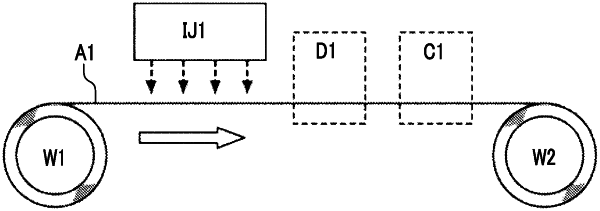| CPC B41M 5/0064 (2013.01) [B41M 5/0023 (2013.01); B41M 7/009 (2013.01); C09D 11/322 (2013.01); B41M 5/0011 (2013.01); B41M 5/0017 (2013.01); B41M 5/0047 (2013.01); C09D 11/10 (2013.01); C09D 11/30 (2013.01); G06F 17/18 (2013.01)] | 7 Claims |

|
1. An image recording method comprising:
preparing a resin base material A in which an absolute value of a distortion rate represented by Equation (a1) in a case where the base material is heated from 25° C. to 60° C. at a temperature increasing rate of 5° C./min and maintained at 60° C. for 2 minutes in a state where a tension of 30 N/m is applied thereto, and the base material is cooled to 25° C. at a temperature decreasing rate of 5° C./min in a state where a tension of 30 N/m is applied thereto is 0.05% or greater;
preparing an ink containing water, a resin X, and a colorant;
applying the ink onto the resin base material A to which a tension S1 of 10 N/m or greater is applied, to obtain an image;
heating and drying the image to a temperature Td of 50° C. or higher in a state where a tension S2 of 10 N/m or greater is applied to the resin base material A; and
cooling the image after the drying to a temperature Tr of 30° C. or lower in a state where a tension S3 of 10 N/m or greater is applied to the resin base material A,
wherein σtotal to be calculated by Equation (1) is 40 kgf/cm2 or less,
distortion rate (%)=((length of resin base material in tension application direction at end of cooling−length thereof in tension application direction at start of heating)/length thereof in tension application direction at start of heating)×100 Equation (a1)
σtotal=|σdry+σcool| Equation (1)
σdry=E(Td)ε(Td) Equation (2)
σcool=∫ETrTd(T)(αr(T)−αs(T))dT Equation (3)
in Equation (1), σdry is calculated by Equation (2), and σcool is calculated by Equation (3),
in Equation (2),
E(Td) represents an elastic modulus of the resin X at the temperature Td which is expressed in a unit of kgf/cm2,
ε(Td) represents an expansion coefficient of the length of the resin base material A represented by Equation (a2) in the tension application direction in a case where the base material is heated from 25° C. to the temperature Td and maintained at the temperature Td in a state where the tension S2 is applied thereto, and the base material is cooled to 25° C. in a state where the tension S2 is applied thereto,
expansion coefficient of length of resin base material A in tension application direction=(length of resin base material in tension application direction at end of cooling−length thereof in tension application direction at start of heating)/length thereof in tension application direction at start of heating Equation (a2)
in Equation (3),
E(T) represents an elastic modulus of the resin X at a temperature T of the image in the cooling which is expressed in the unit of kgf/cm2,
αr(T) represents a linear expansion coefficient of the resin X at the temperature T,
αs(T) represents a linear expansion coefficient of the resin base material A in the tension application direction in a state where the tension S3 is applied thereto at the temperature T,
Td represents the temperature Td, and
Tr represents the temperature Tr.
|